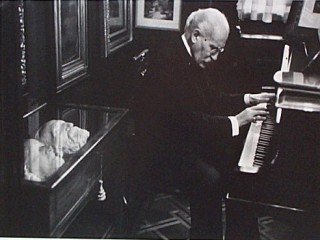
Arturo Toscanini biography
Date of birth : 1867-03-25
Date of death : 1957-01-16
Birthplace : Parma, Italy
Nationality : Italian
Category : Famous Figures
Last modified : 2010-12-21
Credited as : Conductor, ,
The Italian conductor Arturo Toscanini was the most famous and influential conductor of the first half of the 20th century.
Arturo Toscanini was born on March 25, 1867, in Parma, Italy, the son of a tailor. When Arturo showed musical tendencies, he was sent to the local conservatory, where he spent the next 9 years, devoting himself entirely to music. He graduated in 1885 with a first prize in cello and was immediately engaged to play in the orchestra at the Reggia, Parma's famous opera house. During the following summer he joined an orchestra that went to Brazil to play a season of Italian opera. At one performance the regular conductor was unable to appear. The 19-year-old cellist took over and, without a rehearsal, conducted Aida from memory, thus beginning one of the musical world's most illustrious careers.
On returning to Italy, Toscanini was in great demand as an opera conductor. He conducted the first performances of Leoncavallo's I Pagliacci and Puccini's La Bohème. By the time he was 30, he was acknowledged to be the best opera conductor in Italy, and he was appointed principal conductor at La Scala in Milan, Italy's leading opera house. There, with his notorious temper and keen musicianship, he imposed a high performance standard on both singers and orchestra. He also disciplined the audience by refusing to allow the traditional encores that destroyed the musical continuity of the operas. He conducted at La Scala from 1898 to 1903 and again from 1906 to 1908, when he resigned to become a conductor with the Metropolitan Opera Company in New York City.
Toscanini returned to Italy in 1915 and to La Scala when it reopened after World War I. The growth of fascism and Mussolini's dictatorship made it impossible for Toscanini to remain; in 1928 he became conductor of the New York Philharmonic Symphony Orchestra, a post he held until 1936. His harsh discipline and uncompromising musical standards made the Philharmonic one of the world's greatest orchestras.
During these years Toscanini also conducted opera at the famous European music festivals at Salzburg and Bayreuth. In 1937 he became conductor of the National Broadcasting Company Orchestra. This orchestra's broadcast concerts and recordings brought his performances to millions of listeners. He died in New York City on Jan. 16, 1957.
At the time Toscanini started to conduct, late-19th-century performance ideals were prevalent and conductors and performers thought it was their right and duty to "express themselves" in the music they played. Great
liberties in tempi and dynamics were taken, and the score indications were often ignored. Toscanini vigorously opposed this approach, believing that performers should meticulously follow the scores and play every note exactly as written at the precise degree of loudness called for by the composer. He expected his musicians to show as much devotion toward the score and energy in carrying out its directions as he did. If they failed, he was merciless in his criticism.
Toscanini was one of the first to conduct without a score. His visual memory was phenomenal, and he could make minute corrections, referring to exact measures, without looking at the score. This skill was developed partly as a matter of necessity, because he was so nearsighted that he could not read a score at normal distance. He also had a marvelously acute ear, and there are many instances of his hearing a false note in a single instrument, even with the full orchestra playing.
Among the best books on Toscanini are David Ewen, The Story of Arturo Toscanini (1951; rev. ed. 1966); Howard Taubman, The Maestro: The Life of Arturo Toscanini (1951); and Samuel Chotzinoff, Toscanini: An Intimate Portrait (1956). Two books that contain analyses of his interpretations and comparisons of his recordings are Robert C. Marsh, Toscanini and the Art of Orchestral Performance (1956), and Spike Hughes, The Toscanini Legacy (1959).
















